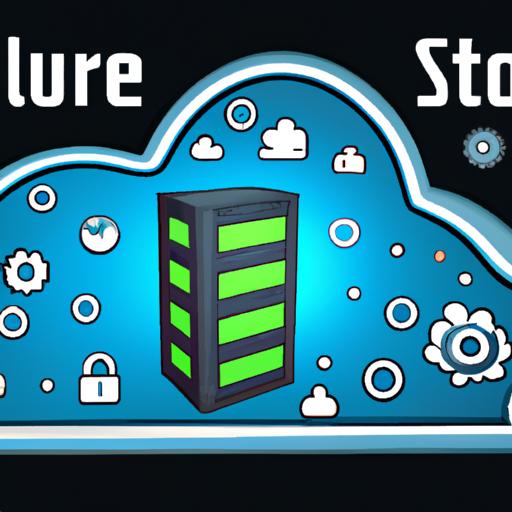The Power of Open Source Cloud Storage: Unleashing the Potential
Introduction
In today’s digital age, where data has become the lifeblood of businesses and individuals alike, the need for efficient and secure storage solutions has reached new heights. Enter open source cloud storage – a revolutionary concept that offers unparalleled flexibility, customization, and cost-effectiveness. But what exactly is open source cloud storage, and why should you consider adopting it?
Definition and Explanation of Open Source Cloud Storage
Open source cloud storage refers to a storage system that allows users to store and access their data in a cloud-based environment. What sets it apart from traditional cloud storage solutions is its open source nature. This means that the underlying source code is freely available, allowing users to modify, customize, and tailor the storage system according to their specific needs.
Importance and Benefits of Using Open Source Cloud Storage
Embracing open source cloud storage brings with it a myriad of benefits that can empower individuals, businesses, and organizations of all sizes. Firstly, it offers a cost-effective alternative to proprietary storage solutions. By utilizing open source technologies, you eliminate the need for expensive licensing fees, enabling you to allocate resources to other critical areas of your operations.
Moreover, open source cloud storage provides unmatched flexibility and customization options. Since the source code is accessible, developers can enhance and modify the storage system to suit their unique requirements. This level of adaptability ensures that the storage solution aligns perfectly with your specific workflows and processes, leading to increased efficiency and productivity.
Additionally, security and privacy are paramount considerations when it comes to storing sensitive data. Open source cloud storage solutions often have a robust community of developers continuously working on improving security measures. With access to the source code, you can identify and address vulnerabilities promptly, ensuring the highest level of data protection.
In conclusion, open source cloud storage presents a game-changing opportunity for individuals and businesses seeking a reliable, customizable, and cost-effective storage solution. By harnessing the power of open source technologies, you can revolutionize the way you store and access data, giving you the freedom to adapt, innovate, and thrive in today’s digital landscape.
- words*
Advantages of Open Source Cloud Storage
In the realm of storage solutions, open source cloud storage stands out with its remarkable advantages. Let’s delve into the key benefits that make it an enticing choice for individuals and businesses alike.
Cost-effectiveness
One of the most significant advantages of open source cloud storage is its cost-effectiveness. Unlike proprietary storage solutions that often come with hefty licensing fees, open source cloud storage allows you to leverage the power of community-driven development without incurring additional expenses. By eliminating licensing costs, you can allocate your resources to other crucial areas of your operations, maximizing your budget and achieving substantial cost savings.
Customization and Flexibility
Open source cloud storage offers an unparalleled level of customization and flexibility. With access to the source code, you have the freedom to modify and tailor the storage system to suit your specific requirements. Whether you need to integrate it with existing workflows or add new features, the open source nature empowers you to adapt the storage solution to your unique needs. This flexibility ensures seamless integration, enhancing productivity and efficiency in your data management processes.
Enhanced Security and Privacy
Data security and privacy are paramount concerns in today’s digital landscape. Open source cloud storage solutions provide enhanced security measures, thanks to the collective efforts of a vibrant developer community. With continuous development and community support, vulnerabilities are identified and addressed promptly, ensuring robust data protection. Moreover, the transparency of the source code allows for thorough audits, enabling you to identify and rectify potential security gaps, further fortifying your data against unauthorized access.
Community Support and Continuous Development
Open source projects thrive on community support, and open source cloud storage is no exception. The active developer community ensures that the storage solution receives constant updates, improvements, and bug fixes. Collaborative development fosters innovation and ensures that the storage system remains up-to-date with the latest technological advancements. Furthermore, the community provides a wealth of resources, forums, and support channels, enabling users to troubleshoot issues effectively and exchange knowledge.
In conclusion, the advantages of open source cloud storage, including its cost-effectiveness, customization, enhanced security, and community support, make it an enticing option for individuals and businesses seeking a reliable and flexible storage solution. By harnessing these advantages, you can unlock the full potential of open source cloud storage and revolutionize the way you store and manage your data.
- words*
Top Open Source Cloud Storage Solutions
When it comes to open source cloud storage solutions, there are several platforms that have gained popularity for their robust features, performance, and scalability. Let’s take a closer look at some of the leading options available:
3.1 Brief Overview of Popular Open Source Cloud Storage Platforms
3.1.1 Nextcloud
Nextcloud is a renowned open source cloud storage platform that offers a comprehensive set of features. It provides users with seamless file synchronization, secure file sharing, and collaboration capabilities. With its user-friendly interface and extensive plugin ecosystem, Nextcloud has become a go-to choice for individuals and organizations looking for a versatile storage solution.
3.1.2 ownCloud
Similar to Nextcloud, ownCloud is another prominent open source cloud storage platform that empowers users to store and manage their data effectively. It boasts features such as file syncing, sharing, and versioning while prioritizing data security and privacy. With a wide range of plugins and extensions, ownCloud allows for seamless integration with existing applications and systems.
3.1.3 Seafile
Seafile is a lightweight open source cloud storage solution that focuses on simplicity and efficiency. It offers secure file synchronization, sharing, and collaboration features, making it an ideal choice for teams and organizations. Seafile also provides clients for various operating systems, ensuring accessibility across different devices.
3.2 Comparison of Features, Performance, and Scalability
When choosing the right open source cloud storage platform, it’s crucial to consider factors such as features, performance, and scalability. Each platform mentioned above excels in different areas, catering to specific needs. Evaluating these aspects can help you make an informed decision based on your unique requirements.
Consider the features offered by each platform, such as file syncing, sharing, collaboration, encryption, and integration capabilities. Assess their performance in terms of speed, reliability, and responsiveness, as these factors directly impact user experience. Additionally, scalability is vital to accommodate future growth, ensuring that the storage solution can handle increased data volumes and user demands.
By comparing these key factors, you can determine which open source cloud storage platform aligns best with your needs, allowing you to harness the full potential of open source storage technology.
- words*
Implementing Open Source Cloud Storage
Step-by-Step Guide on How to Set Up Open Source Cloud Storage
Implementing open source cloud storage may seem daunting at first, but with the right guidance, you can get your storage system up and running smoothly. Here’s a step-by-step guide to help you through the process:
-
Evaluate Your Storage Needs: Begin by assessing your storage requirements, including the volume of data, anticipated growth, and specific features you need. This evaluation will help you choose the most suitable open source cloud storage solution for your needs.
-
Select the Right Hardware: Determine the hardware infrastructure needed to support your open source cloud storage system. Consider factors such as storage capacity, network bandwidth, and redundancy requirements. Opt for reliable hardware components to ensure optimal performance and data integrity.
-
Choose the Ideal Software: Research and select the open source cloud storage software that aligns with your goals and requirements. Popular choices include ownCloud, Nextcloud, and Seafile, each offering unique features and functionalities. Take into account factors like scalability, security, and community support when making your decision.
-
Install and Configure: Follow the installation instructions provided by the chosen open source cloud storage software. Set up the necessary dependencies and configure the system according to your preferences. Ensure that you implement security measures, such as enabling encryption and user authentication, to protect your data.
-
Deploy and Test: Once the installation and configuration are complete, deploy your open source cloud storage system. Conduct thorough testing to ensure all features and functionalities are working as intended. This step allows you to identify any issues or areas for improvement before deploying the system for real-world usage.
Hardware and Software Requirements
To implement open source cloud storage successfully, you’ll need to meet certain hardware and software requirements. Here are some key considerations:
-
Hardware: Ensure you have sufficient storage capacity, network bandwidth, and processing power to handle your data storage needs. Invest in reliable and scalable hardware components to accommodate future growth.
-
Software: Choose a compatible operating system that supports the open source cloud storage software you’ve selected. Additionally, make sure you have the necessary dependencies and libraries installed as specified by the software documentation.
Configuration and Deployment Process
The configuration and deployment process of open source cloud storage varies depending on the chosen software. Refer to the official documentation provided by the software developers for detailed instructions. Typically, the process involves adjusting settings, customizing user access permissions, and integrating with existing authentication systems if required.
By following this step-by-step guide and ensuring you meet the hardware and software requirements, you’ll be on your way to implementing a robust and efficient open source cloud storage system.
- words*
Best Practices for Open Source Cloud Storage
In order to maximize the benefits of open source cloud storage and ensure the utmost security and efficiency, it is crucial to follow best practices. By implementing these recommended strategies, you can safeguard your data, optimize performance, and mitigate potential risks. Let’s explore some of the key best practices for utilizing open source cloud storage effectively.
Data Backup and Disaster Recovery Strategies
Data loss can be catastrophic for any organization, leading to financial and reputational damage. Therefore, implementing robust data backup and disaster recovery strategies is essential. Take advantage of the features provided by your open source cloud storage solution to automate regular backups of your critical data. This ensures that in the event of a hardware failure, natural disaster, or cyber attack, you can quickly restore your data and resume operations seamlessly.
Consider adopting a multi-tiered backup approach, with redundant copies stored in multiple locations. This reduces the risk of data loss and enhances disaster recovery capabilities. Regularly test your backup and recovery processes to identify any potential gaps and ensure the integrity of your data.
Security Measures and Encryption Techniques
Maintaining the security and privacy of your data is of utmost importance in today’s digital landscape. Open source cloud storage solutions often provide robust security features, but it’s essential to implement additional measures to safeguard your information. Utilize strong access controls and authentication mechanisms to restrict unauthorized access to your data.
Encryption plays a vital role in protecting sensitive data. Implement end-to-end encryption for data in transit and at rest to ensure that even if an unauthorized party gains access to your data, they won’t be able to decipher it. Regularly update your encryption keys and follow industry best practices to stay ahead of potential security threats.
Performance Optimization Tips
To ensure optimal performance of your open source cloud storage solution, consider implementing the following tips. Optimize your network infrastructure to ensure high-speed connectivity between your storage system and users. Utilize caching mechanisms to reduce latency and improve data retrieval times.
Additionally, optimize your storage system configuration by fine-tuning parameters such as block sizes, cache sizes, and data placement policies. Regularly monitor and analyze performance metrics to identify any bottlenecks or areas for improvement.
By implementing these best practices, you can maximize the potential of open source cloud storage, ensuring the security, reliability, and performance of your data storage solution.
- words*
Future of Open Source Cloud Storage
The future of open source cloud storage holds immense potential as technology continues to advance and evolve. As businesses and individuals increasingly rely on cloud-based solutions, open source cloud storage is poised to play a pivotal role in shaping the storage landscape of tomorrow.
Emerging Trends and Innovations in the Field
One of the key trends in open source cloud storage is the integration of artificial intelligence (AI) and machine learning (ML) capabilities. These technologies can enhance data management, automate processes, and improve overall system performance. With AI-driven algorithms, open source cloud storage solutions can intelligently optimize storage allocation, minimize resource wastage, and provide real-time insights into data usage patterns.
Another emerging trend is the integration of blockchain technology with open source cloud storage. Blockchain’s decentralized and immutable nature can enhance security and data integrity, providing users with an added layer of trust and transparency. By leveraging blockchain, open source cloud storage solutions can securely track and verify data transactions, making it ideal for industries that require auditable and tamper-proof records.
Potential Challenges and Solutions
While the future of open source cloud storage appears promising, it is not without its challenges. One potential concern is the complexity of managing and maintaining open source solutions. However, with the growing community support and a wealth of online resources available, users can find guidance and assistance in troubleshooting issues, ensuring the smooth operation of their open source cloud storage systems.
Additionally, as the demand for data storage continues to skyrocket, scalability becomes a critical consideration. Open source cloud storage solutions must be able to handle massive amounts of data and accommodate the expanding needs of users. Fortunately, ongoing advancements in hardware and software technologies provide solutions for scaling open source cloud storage systems, ensuring seamless performance and uninterrupted access to data.
Predictions for the Growth and Adoption of Open Source Cloud Storage
Looking ahead, it is evident that open source cloud storage will witness significant growth and widespread adoption across industries. The cost-effectiveness, flexibility, and security offered by open source solutions will continue to attract businesses seeking agile and customizable storage options.
Moreover, the collaborative nature of open source development fosters innovation and drives rapid advancements in the field. As more developers contribute their expertise and ideas, open source cloud storage solutions will continue to evolve, surpassing the capabilities of proprietary counterparts.
In conclusion, the future of open source cloud storage is bright and promising. With emerging trends such as AI integration and blockchain technology, as well as solutions to challenges like complexity and scalability, open source cloud storage is poised to revolutionize the way we store, manage, and access data.
- words*





